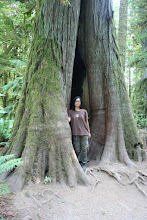Nancy Karraker - Research Assistant Professor - (All photos taken by Nancy Karraker; |
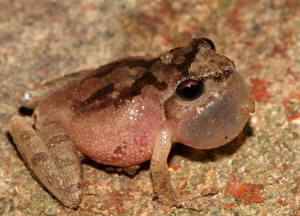 |
Not many places as small as Lamma Island can claim the discovery of a new animal. Romer's tree frog, also known by the scientific name Liuixalus romeri, was first discovered by J.D. Romer in a small cave on South Lamma Island in 1952. When the roof of the cave collapsed and other frogs were not found nearby, it was believed until as recently as 1984 that the species was extinct. It was then rediscovered in the so-called Kamikaze Caves and has since been found all over Lamma Island.
While it was first known from Lamma, the species also naturally occurs on Lantau, Po Toi, and Chep Lap Kok islands. Most of the population from Chep Lap Kok was translocated to eight sites in the New Territories and Hong Kong Island when the new airport was being built and seven of those sites still harbor significant populations of frogs. Internationally, this is known as one of the first successful translocation efforts for an amphibian and is a model followed by people trying to preserve amphibians in other parts of the world. While the species was long considered to be endemic to, or occur only in, Hong Kong, it has recently been found in Guangdong Province, though its distribution there is not well-known.
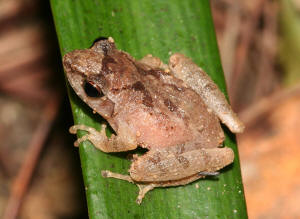 Romer's tree frog is one of the world's tiniest frogs, about two centimeters in size, and brown or gray often with an 'x' pattern on its back. Most people never see Romer's tree frogs because they are small and well-camouflaged, usually occur in dense vegetation, and the males stop calling when they perceive danger approaching. While they are classified as tree frogs, and have suction discs on the tip of each toe, they are not known to climb vegetation and prefer to spend their time on the ground. They are fairly unique in their breeding habits, as Hong Kong amphibians go, in that they choose ephemeral pools or those that dry up every year. Researchers at the University of Hong Kong found that fish can be significant predators on their eggs and tadpoles, so it is likely that they breed in sites that dry up every year and thus cannot harbor fish. Males position themselves near a pool and emit a staccato call that sounds like a loud cricket. This call can be heard on warm, rainy nights from February to September all over Lamma Island. Presumably, a female ready to mate moves toward the pool and chooses the male with the 'best' call. In many frogs, deeper calls are usually given by larger, older males. An older male has managed to survive longer than others and must be 'fitter' than others with higher-pitched calls. Often in a chorus of calling frogs, you can hear a few high-pitched, squeaky calls. These are usually males who are attempting to breed for the first time. They will only be chosen only if there are not more attractive options available. After a mate has been chosen, the female attaches up to 120 eggs in small groups to submerged sticks or leaves, with the male riding along on her back and fertilizing as they go. The tadpoles are tiny and brown in color and undergo metamorphosis (transition from tadpole to frog) in about four to six weeks. Adults probably live two to three years and breed once or twice in their lifetimes.
Romer's tree frog is one of the world's tiniest frogs, about two centimeters in size, and brown or gray often with an 'x' pattern on its back. Most people never see Romer's tree frogs because they are small and well-camouflaged, usually occur in dense vegetation, and the males stop calling when they perceive danger approaching. While they are classified as tree frogs, and have suction discs on the tip of each toe, they are not known to climb vegetation and prefer to spend their time on the ground. They are fairly unique in their breeding habits, as Hong Kong amphibians go, in that they choose ephemeral pools or those that dry up every year. Researchers at the University of Hong Kong found that fish can be significant predators on their eggs and tadpoles, so it is likely that they breed in sites that dry up every year and thus cannot harbor fish. Males position themselves near a pool and emit a staccato call that sounds like a loud cricket. This call can be heard on warm, rainy nights from February to September all over Lamma Island. Presumably, a female ready to mate moves toward the pool and chooses the male with the 'best' call. In many frogs, deeper calls are usually given by larger, older males. An older male has managed to survive longer than others and must be 'fitter' than others with higher-pitched calls. Often in a chorus of calling frogs, you can hear a few high-pitched, squeaky calls. These are usually males who are attempting to breed for the first time. They will only be chosen only if there are not more attractive options available. After a mate has been chosen, the female attaches up to 120 eggs in small groups to submerged sticks or leaves, with the male riding along on her back and fertilizing as they go. The tadpoles are tiny and brown in color and undergo metamorphosis (transition from tadpole to frog) in about four to six weeks. Adults probably live two to three years and breed once or twice in their lifetimes.
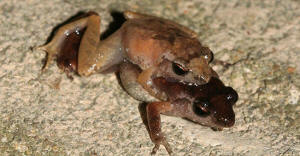 |
Romer's tree frogs are one of only three amphibian species listed under the Wild Animals Protection Ordinance in Hong Kong (in contrast, all wild birds are protected under this ordinance). Globally, this species is listed as Endangered by the International Union for the Conservation of Nature and this organization has determined that populations are declining, primarily due to habitat fragmentation and development. In Hong Kong, actual protection of this species varies depending upon particular circumstances. For example, the current dumping of construction rubble in the lower end of Yung Shue Long valley continues unabated despite the fact that Romer's tree frogs have been documented to breed in the area over the past three years.
Several loopholes in Hong Kong's regulations limit government staff from taking action on small projects. Under the Wild Animals Protection Ordinance: No person shall, except in accordance with a special permit, hunt or willfully disturb any protected wild animal. Unless the landowner responsible 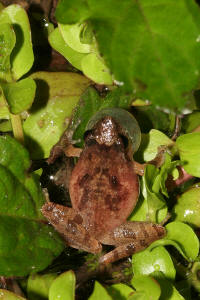 for destruction of Romer's tree frog habitat can be shown to have done so with "will", there is no violation of the law. In the Yung Shue Long valley case, the staff of the Department of Agriculture, Fisheries, and Conservation (AFCD) has notified the Lands Department and the Department of Environmental Protection about the presence of Romer's tree frogs in the area and have asked these departments to notify the landowner. Obviously, the concern is that one could continue to destroy habitat "without will" all the way up the Yung Shue Long valley and in time no habitat would remain.
for destruction of Romer's tree frog habitat can be shown to have done so with "will", there is no violation of the law. In the Yung Shue Long valley case, the staff of the Department of Agriculture, Fisheries, and Conservation (AFCD) has notified the Lands Department and the Department of Environmental Protection about the presence of Romer's tree frogs in the area and have asked these departments to notify the landowner. Obviously, the concern is that one could continue to destroy habitat "without will" all the way up the Yung Shue Long valley and in time no habitat would remain.
In other cases, however, the government has made important efforts in collaboration with others to protect existing populations of Romer's tree frog. The translocation effort at Chep Lap Kok is a good example. An attempt is currently being made to protect and restore a large population in Sok Kwu Wan. The Civil Engineering and Development Department determined that a slope near the village of Sok Kwu Wan was unstable, and they initiated a plan for slope stabilization work. A large population of Romer's tree frogs existed nearby and there was concern that the work would disturb the population and potentially destroy the habitat. In conjunction with Dr. Michael Lau of Kadoorie Farm and Botanical Garden, who led the Chep Lap Kok translocation project, and Mr. Sung Yik Hei, a M.Phil. student at the University of Hong Kong, a proposal was made to collect as many adults, eggs, and tadpoles as possible from the site, maintain them in captivity until the work was finished, and then return them after the habitat was restored. The proposal was approved by the Department of Agriculture, Fisheries, and Conservation and the project was initiated in the summer of 2008.
Over a four-month period last summer, volunteers from AFCD, Kadoorie Farm and Botanical Garden, and the University of Hong Kong visited the site at night every other week to collect Romer's tree frogs, which were then transported to a captive breeding facility at the University of Hong Kong. Approximately 100 adults were collected along with many eggs and tadpoles. Under Sung Yik Hei's care, the captive population flourished and overcrowding became a potential problem, so several months later about 30 adults and 30 juveniles were released at a new, suitable habitat in Sok Kwu Wan, not far from the original site. 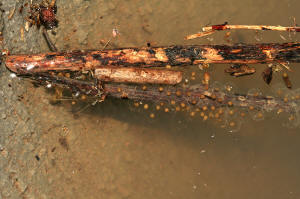 The population continues to grow and another 30 adults and 30 juveniles will be released at the new site next week. Slope stabilization work will be completed in mid-May and the Romer's tree frog habitat will be restored with the guidance of Dr. Billy Hau of the University of Hong Kong, an expert on habitat restoration. At some point in the late summer, the entire captive population will be returned to the original site. If habitat restoration was successful, the population should be secure.
The population continues to grow and another 30 adults and 30 juveniles will be released at the new site next week. Slope stabilization work will be completed in mid-May and the Romer's tree frog habitat will be restored with the guidance of Dr. Billy Hau of the University of Hong Kong, an expert on habitat restoration. At some point in the late summer, the entire captive population will be returned to the original site. If habitat restoration was successful, the population should be secure.
While known only by name to most people on Lamma Island, this tiny frog is a symbol of what most of us appreciate about this island, its natural environment. First discovered here, we should do what we can to make sure that Romer's tree frogs remain for future residents and visitors to learn about and enjoy. If a tiny, brown frog darts quickly across your path, you may have seen a Romer's tree frog.
If you are not so lucky to see one, any of us can enjoy the calls at night. Listen to their call (in MP3 format) and remember for those warm, rainy nights when you are out for a walk.
